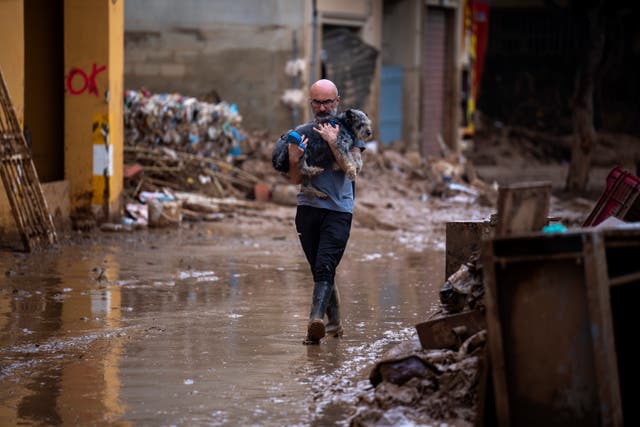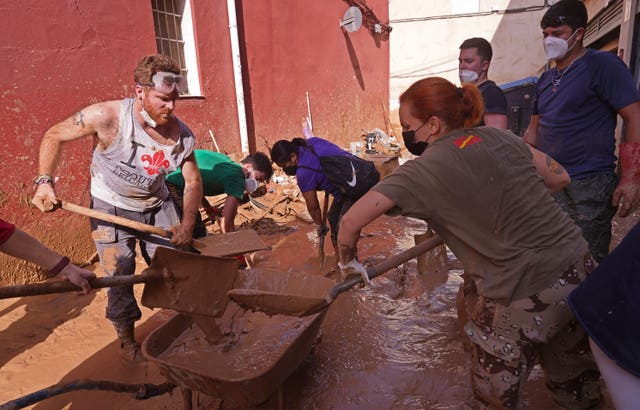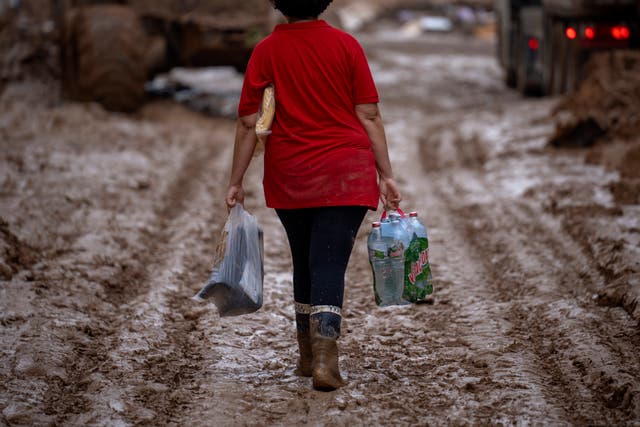
In a matter of minutes, flash floods caused by heavy downpours in eastern Spain swept away almost everything in their path.
With no time to react, people were trapped in vehicles, homes and businesses. Many died and thousands of livelihoods were shattered.
A week later, authorities have recovered 219 bodies — 211 of them in the eastern region of Valencia — and are searching for at least 93 people who are unaccounted for.

Police, firefighters and soldiers continued to search on Tuesday for an unknown number of missing people.
In many of the over 70 impacted localities, mostly located in the southern outskirts of the city of Valencia, people still face shortages of basic goods.
Water is back to running through pipes but authorities say it is only for cleaning and not fit for drinking.
Lines formed at impromptu emergency kitchens and food relief stands in streets still covered with mud and debris.
Spain’s Consortium for Insurance, a public-private entity that pays insurance claims for extreme risks like floods, said on Tuesday that it had received 21,000 claims of home insurance, 12,000 for business properties, and 44,000 for motor vehicles for flood damage. Those numbers are expected to grow.
“We can estimate that we are facing the biggest payout for a weather-related event that Spain has ever suffered,” said Mirenchu del Valle Schaan, president of Spain’s Association of Insurance Companies.
Thousands of volunteers are helping soldiers and police reinforcements with the gargantuan task of cleaning up the mire and the countless wrecked cars.
The ground floors of thousands of homes have been ruined.

Inside some of the vehicles that the water washed away or trapped in underground garages, there were still bodies waiting to be identified.
The frustration over the crisis management boiled over on Sunday when a crowd in hard-hit Paiporta hurled mud and other objects at Spain’s royals, Prime Minister Pedro Sanchez and regional officials when they made their first visit to the epicentre of the flood damage.
Another seven people died in Castilla La Mancha and one in Andalusia.
Here are a few things to know about Spain’s deadliest natural disaster of the century.
– What happened?
The storms concentrated over the Magro and Turia river basins and, in the Poyo canal, produced walls of water that overflowed riverbanks, catching people unaware as they went on with their daily lives on Tuesday evening and early into Wednesday.
In the blink of an eye, the muddy water covered roads and railways, and entered houses and businesses in towns and villages on the southern outskirts of Valencia.
Drivers had to take shelter on car roofs, while residents took refuge on higher ground.
Spain’s national weather service said that in the hard-hit locality of Chiva, it rained more in eight hours than it had in the preceding 20 months, calling the deluge “extraordinary”.

Other areas on the southern outskirts of Valencia city did not get rain before they were wiped out by the wall of water that overflowed the drainage canals.
When authorities sent alerts to mobile phones warning of the seriousness of the flooding and asking people to stay at home, many were already on the road, working or covered in water in low-lying areas or underground garages, which became death traps.
– Why did these massive flash floods happen?
Scientists trying to explain what happened see two likely connections to human-caused climate change.
One is that warmer air holds and then dumps more rain. The other is possible changes in the jet stream — the river of air above land that moves weather systems across the globe — that spawn extreme weather.
Climate scientists and meteorologists said the immediate cause of the flooding is called a cut-off lower-pressure storm system that migrated from an unusually wavy and stalled jet stream.
That system simply parked over the region and poured rain. This happens often enough that in Spain they call them Danas, the Spanish acronym for the system, meteorologists said.
And then there is the unusually high temperature of the Mediterranean Sea.
It had its warmest surface temperature on record in mid-August, at 28.47 degrees Celsius (83.25 degrees Fahrenheit), said Carola Koenig of the Centre for Flood Risk and Resilience at Brunel University of London.

The extreme weather event came after Spain battled with prolonged droughts in 2022 and 2023. Experts say that drought and flood cycles are increasing with climate change.
“Climate change kills, and now, unfortunately, we are seeing it firsthand,” Mr Sanchez said on Tuesday after announcing a 10.6-billion-euro relief package for 78 municipalities where at least one person had died.
– Has this happened before?
Spain’s Mediterranean coast is used to autumn storms that can cause flooding, but this episode was the most powerful flash flood in the region in recent memory.
Older people in Paiporta, at the epicentre of the tragedy, say the floods were three times as bad as those in 1957, which caused at least 81 deaths.
That episode led to the diversion of the Turia watercourse, which meant that a large part of the town was spared of these floods.
Valencia suffered two other major Danas in the 1980s, one in 1982 with around 30 deaths, and another one five years later that broke rainfall records.
– What has the state response been?
Management of the crisis is in the hands of the regional Valencian authorities, who asked the central government for help in mobilising resources.
Some 15,000 soldiers, National Police officers, and Civil Guard gendarmeries have deployed to the area in the largest peacetime mobilisation of military and security forces inside Spain.
Military trucks, heavy road equipment, Chinook helicopters, and a navy transport vessel are aiding with the distribution of relief aid, the cleaning, and the search for bodies.
Two thousand firefighters and 500 local police are also involved.
The national government said that as of Tuesday authorities had rescued over 36,000 people, restored electricity to 147,000 homes and distributed some 130,000 bottles of water and 21,000 food rations.
When many of those affected said they felt abandoned by the authorities, a wave of volunteers arrived to help.
Carrying brooms, shovels, water and basic foods, hundreds of people walked several kilometres to deliver supplies and help clean up the worst-affected areas.
The Valencian regional government has been heavily criticised for not sending out flood warnings to mobile phones until 8pm on Tuesday, when the flooding had already started in some places and well after the national weather agency issued a red alert indicating heavy rains.


Why are you making commenting on The Herald only available to subscribers?
It should have been a safe space for informed debate, somewhere for readers to discuss issues around the biggest stories of the day, but all too often the below the line comments on most websites have become bogged down by off-topic discussions and abuse.
heraldscotland.com is tackling this problem by allowing only subscribers to comment.
We are doing this to improve the experience for our loyal readers and we believe it will reduce the ability of trolls and troublemakers, who occasionally find their way onto our site, to abuse our journalists and readers. We also hope it will help the comments section fulfil its promise as a part of Scotland's conversation with itself.
We are lucky at The Herald. We are read by an informed, educated readership who can add their knowledge and insights to our stories.
That is invaluable.
We are making the subscriber-only change to support our valued readers, who tell us they don't want the site cluttered up with irrelevant comments, untruths and abuse.
In the past, the journalist’s job was to collect and distribute information to the audience. Technology means that readers can shape a discussion. We look forward to hearing from you on heraldscotland.com
Comments & Moderation
Readers’ comments: You are personally liable for the content of any comments you upload to this website, so please act responsibly. We do not pre-moderate or monitor readers’ comments appearing on our websites, but we do post-moderate in response to complaints we receive or otherwise when a potential problem comes to our attention. You can make a complaint by using the ‘report this post’ link . We may then apply our discretion under the user terms to amend or delete comments.
Post moderation is undertaken full-time 9am-6pm on weekdays, and on a part-time basis outwith those hours.
Read the rules hereLast Updated:
Report this comment Cancel